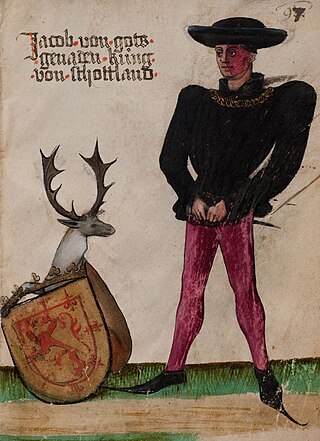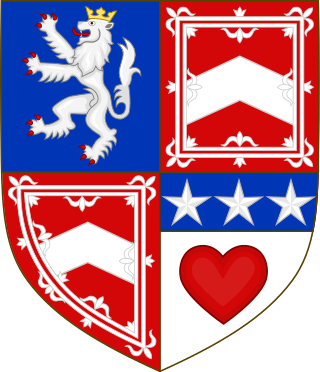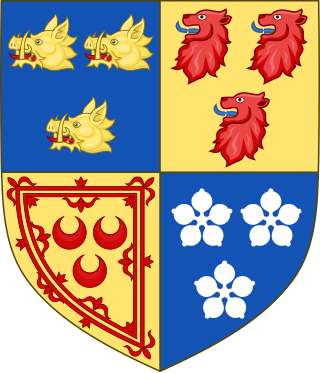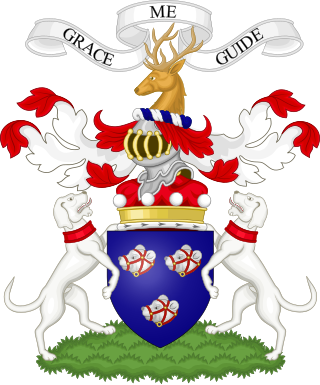
James II was King of Scots from 1437 until his death in 1460. The eldest surviving son of James I of Scotland, he succeeded to the Scottish throne at the age of six, following the assassination of his father. The first Scottish monarch not to be crowned at Scone, James II's coronation took place at Holyrood Abbey in March 1437. After a reign characterised by struggles to maintain control of his kingdom, he was killed by an exploding cannon at Roxburgh Castle in 1460.

John Douglas, 2nd Earl of Morton died 9 September 1513 at the Battle of Flodden.
George Leslie, 4th Earl of Rothes was a Scottish nobleman and diplomat.
Alexander Livingston, 5th Lord Livingston of Callendar PC was the guardian of Mary, Queen of Scots, during her childhood.

William, 6th Earl of Douglas was a Scottish nobleman. In addition to his Earldom of Douglas, he was Earl of Wigtown, Lord of Galloway, Lord of Bothwell, Selkirk and Ettrick Forest, Eskdale, Lauderdale, and Annandale in Scotland, and de jure Duke of Touraine, Count of Longueville, and Lord of Dun-le-roi in France. He was the eldest son of Archibald Douglas, 5th Earl of Douglas and Lady Eupheme Graham.

James Douglas, 7th Earl of Douglas, 1st Earl of Avondale, latterly known as James the Gross, and prior to his ennoblement as James of Balvenie, was a late mediaeval Scottish magnate. He was the second son of Archibald Douglas, 3rd Earl of Douglas, and Joan Moray of Bothwell and Drumsargard, d. after 1408.

Alexander Seton, 1st Earl of Huntly, who adopted the family name of Gordon from about 1457, was a powerful 15th-century Scottish magnate. He was knighted in 1439/1440 and was Lord of Badenoch, Gordon, Strathbogie and Cluny.
George Gordon, 2nd Earl of Huntly was a Scottish nobleman and Chancellor of Scotland from 1498 to 1501.
William Crichton, 1st Lord Crichton was an important political figure in the late medieval Kingdom of Scotland.
Sir James Hamilton of Cadzow, 5th Laird of Cadzow was a Scottish nobleman and royal hostage.
William Douglas, 1st Marquess of Douglas and 11th Earl of Angus (1589–1660) was a Scottish nobleman.

Clan Forbes is a Highland Scottish clan from Aberdeenshire, Scotland.
William Crichton (1598–1691) was the 2nd Earl of Dumfries and a privy councillor to Charles II of England. After the Glorious Revolution, Crichton resigned his titles on 10 September 1690 and had them restored on 3 November 1690 by the new King William III of England. Although he produced two sons, they both pre-deceased William, so his titles passed to his grandson William.
Margaret Stewart was the younger daughter of James II of Scotland and Mary of Guelders. Once engaged to the Lancastrian Prince of Wales, Margaret instead became the mistress of William Crichton, 3rd Lord Crichton, and the mother of his illegitimate daughter, Margaret Crichton, later Countess of Rothes, and possibly his son, Sir James Crichton, progenitor of the Viscounts of Frendraught. Margaret and Lord Crichton may have been married later, after the death of Crichton's wife.
John Maxwell, 4th Lord Maxwell was a Scottish nobleman and patriarch of the Border Family / House / Clan of Maxwell.

William Keith, 4th Earl Marischal was a Scottish nobleman and politician.
George Livingston PC was a military officer and third Earl of Linlithgow.
William Ruthven, 1st Lord Ruthven was a Scottish nobleman and founder of the noble lines of the Ruthven family.
James Livingston, 1st Lord Livingston was a Scottish nobleman.
Alexander Abernethy, 6th Lord Saltoun was a Scottish landowner and courtier.






